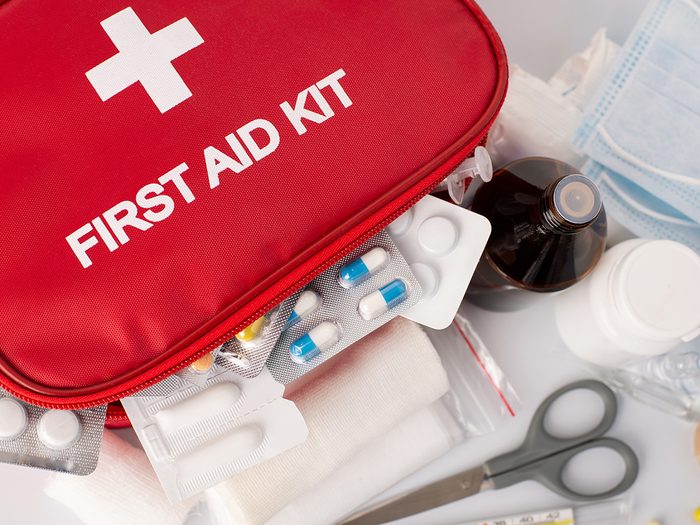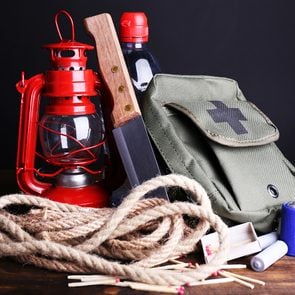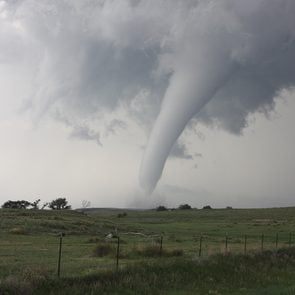What You Should Keep in a First Aid Kit

Is your first aid kit ready for an emergency? Here are the must-have supplies in every well-stocked kit, according to the experts.
The last time I cracked open my home’s first aid kit, I had one thumb swaddled in bloody paper towels after I’d accidentally nicked it while chopping onions. Fumbling through the zippered compartments as my thumb throbbed, I discovered nothing but a few yellowed bandages, dried-out antiseptic wipes, some gauze, tape and a pair of scissors that looked like the kind kids get in kindergarten.
Luckily I managed to stem the bleeding with the gauze and went on to cook a decent spaghetti bolognese. But I’d come to the sober realization that my cheap, neglected first aid kit would do my family no good in an honest-to-goodness emergency.
To help you make sure yours contains all the right things, we spoke to experts in emergency medicine. Here are the first aid kit contents every Canadian should have on hand.
First Aid Kit Contents: A Checklist
Aspirin: Two 81-milligram tablets of chewable acetylsalicylic acid (Aspirin) can be life-saving if taken within the first hour of a suspected heart attack. But call 911 first and await instructions; it’s not safe for everyone (for example, those on other blood thinners).
Disposable non-latex gloves: When helping another person, put these on to decrease the risk of disease transmission.
Hand sanitizer: This can be used to clean your hands when soap and water aren’t available; use it before putting on the gloves.
Antiseptic wipes: If you don’t have access to clean running water, use these to clean and disinfect cuts before applying a bandage or ointment.
Antibacterial ointment: This helps prevent infection by stopping the growth of bacteria in minor wounds.
Hydrocortisone cream: It relieves itching and irritation from insect bites or poisonous plants. You can get it in single-use packets.
Abdominal dressings: These large dressings can help control heavy bleeding from major wounds. Keep firm pressure on the dressed wound until help arrives.
Gauze: Both the squares and the rolls are good for packing and dressing dressing wounds, and stabilizing protruding objects (which you should never pull out).
Waterproof adhesive tape: This firmly secures the dressing on a wound. Self-adhesive bandages: Have a variety of sizes in your kit, for minor cuts and scrapes.
Triangular bandage: This can be used as an arm sling.
Tweezers: The type with pointed tips, which allow for the removal of ticks or splinters and for cleaning debris from a wound, are ideal.
Trauma shears: It’s worth having good scissors so you can quickly and easily cut thick bandages or clothing. Trauma shears have a sharp, serrated blade.
CPR face shield: If you need to perform rescue breaths, these shields, with a one-way valve, are a good barrier against bacteria and viruses.
Instant cold packs: Activated when you squeeze them, they help reduce pain and swelling for muscle sprains or bruises.
Burn hydrogel: Gel-saturated burn pads cool and soothe damaged skin; they’re ideal when it’s not possible to run skin under cool water.
Mylar blanket: These “space blankets” help maintain a person’s core temperature after a severe injury or shock.
Assembling Your First Aid Kit
It’s important to keep these items nearby and accessible, because you never know when you’ll need them. In the United States, more medically reported injuries happen at home than in public places, at the workplace and on the road—combined. In Canada, one-quarter of accidental falls requiring emergency care happen at home, and in the European Union, seven percent of adults experience an injury-causing accident at home or during a leisure pursuit every year.
Yet many of us are unprepared: 70 percent of Britons say their household isn’t ready for an emergency, and 44 percent of Americans don’t own a first aid kit, even though it’s considered an essential item for your home, car and camping pack.
“First aid kits are most commonly used for minor injuries like cuts, but they can also help you in less-common emergency situations, such as heart attacks or life-threatening bleeding,” says Dr. Nathan Charlton, an emergency physician in Charlottesville, Virginia, who serves on the Scientific Advisory Council for the American Red Cross.
If you are in the market for a first aid kit, here are some basics to keep in mind.
Buy the Right Container
Your first aid kit contents should be kept in a waterproof bag or an airtight container with clear compartments that allow you to see what’s inside. That way you won’t have to dig around or dump things out of your kit just to see where an item is. A good quality ready-made first aid kit should have most, if not all, of what you need. Look for one created by a reputable organization like the Red Cross or St. John Ambulance, which are sold at major retailers. If any first aid kit contents are missing, buy them separately.
Check Expiry Dates
Add a monthly notification to your calendar to ensure medications in the kit are up to date. “That also reminds you why you have a first aid kit, and it may also help you recall any training you’ve had,” Charlton says.
Get Some Training
There’s no better way to prepare yourself for emergencies than by taking a course. Around the world, organizations like the Red Cross, Red Crescent and St. John Ambulance offer basic first aid and CPR certifications that can be completed over a weekend.
They also publish manuals, some in pocket size that you can keep in your kit. These guides can steer you through a range of scenarios—from panic attacks to spinal injuries—with pictograms. To be even better prepared, you can download the Red Cross First Aid app on your smartphone to update and maintain your life-saving skills. The Red Cross also offers an online course on how to recognize signs of an opioid overdose and administer the lifesaving medication naloxone (or Narcan).
Know the Essentials
When cleaning cuts, don’t use hydrogen peroxide (it shouldn’t be in your first aid kit). “It can cause the skin at the edges of the cut to dry out, preventing it from healing cleanly,” says Lyle Karasiuk, volunteer chair of the Canadian Council for First Aid Education.
Instead, use soap and water, then an antibacterial cream. Any cut longer than 2.5 centimetres will need stitches, says Karasiuk, noting that you should also seek health care if bleeding does not stop after 10 minutes of pressure.
The most life-saving item may be a tourniquet—a device that constricts arteries in a limb to stop severe blood loss, which can kill in minutes. Use it when the bleeding from an extremity is so severe that direct pressure can’t stop it. You can improvise one using a minimum two-inch-wide strip of cloth and a small tree branch, but a commercially made tourniquet is better.
The latest models consist of a wide nylon strap with a turn crank and use a locking mechanism to eliminate slack. They should be placed one hand width above the injury. “Once you apply a tourniquet, do not take it off until help arrives,” says Karasiuk.
Finally, keep a first aid kit in your car, plus a reflective vest and a warning triangle to put beside the vehicle.
Now that you’ve got the first aid kit contents you’ll need to respond to an emergency, test your knowledge with our first aid quiz.






